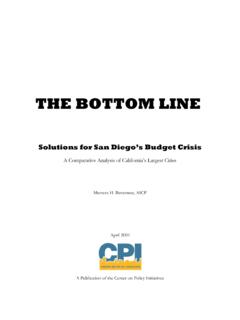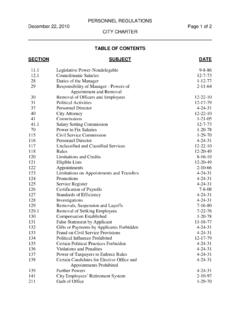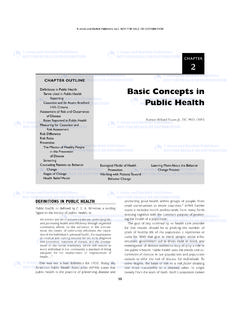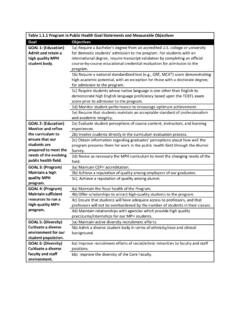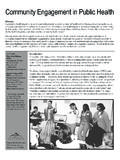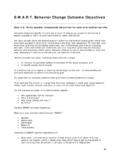Transcription of Public Utilities Department Report on Water Quality ...
1 Public Utilities Department Report on Water Quality Relative to Public health goals June 30, 2013 Background: Provisions of the California health and Safety Code specify that the City of San Diego Public Utilities Department , and other Water Utilities with more than 10,000 service connections, prepare a special Report by July 1, 2013, if their Water Quality measurements exceeded any Public health Goal (PHG) in calendar years 2010, 2011 and 2012. PHGs are non-enforceable goals established by the California Office of Environmental health Hazard Assessment (OEHHA). The law also requires that where OEHHA has not adopted a PHG for a contaminant, the Water suppliers are to use the Maximum Contaminant Level goals (MCLGs) adopted by the Environmental Protection Agency (USEPA).
2 Only contaminants that have an existing enforceable mandatory Maximum Contaminant Level (MCL) and have exceeded either a PHG or MCLG are to be addressed in this Report . Included in this Report is the numerical Public health risk associated with the MCL and PHG or MCLG, the category or type of risk to health that could be associated with each contaminant, and an estimate of the cost to implement specific treatment if it is appropriate and feasible. PHGs are set by the OEHHA and are based solely on Public health risk considerations. None of the practical risk management factors that are considered by the USEPA or the California Department of Public health ( CDPH) in setting MCLs are considered in setting the PHGs.
3 These factors include analytical detection capabilities, treatment technology availability, benefits and costs. The PHGs are not enforceable and are not required to be met by any Public Water system. MCLGs are the USEPA s equivalent to PHGs. Water Quality Data Considered: All of the Water Quality data collected by our Water system between 2010 and 2012 for purposes of determining compliance with drinking Water standards were considered for this Report . These data were summarized in our 2010, 2011 and 2012 annual Consumer Confidence Reports, which were mailed or distributed electronically to all of our customers in June of each year. Copies of these reports and additional information concerning Water Quality and the Public Utilities Department may be viewed at Best Available Treatment Technology and Cost Estimates: Both the USEPA and CDPH specify best available technologies (BATs), which are the best known methods of reducing contaminant levels, to meet the legally enforceable MCL.
4 Costs can be estimated for such technologies. However, since many PHGs and MCLGs are set much lower than the MCL, it is not always possible, nor feasible, to determine what treatment is needed to further reduce a contaminant to the PHG or MCLG, many of which are set at zero. In some cases, installing treatment to try and further reduce very low levels of one contaminant may have adverse effects on other aspects of Water Quality . For example, using reverse osmosis will reduce the hardness of the Water , but would increase corrosion within the distribution system. The increased corrosion would decrease the life expectancy of the Water mains and household plumbing.
5 Corrosion also increases lead and copper dissolving from household plumbing. Contaminants Detected that Exceed a PHG or a MCLG: During the years 2010, 2011, and 2012 considered for this Report , there were no constituents that exceeded state or federal compliance standards. However, there were a few that were above the PHG or MCLG. Water delivered in the City of San Diego that exceeded the PHG s or MCLG s during this period is summarized below: uranium ranged from to pCi/L (picocuries per liter), well below the 20 pCi/L MCL; the uranium Public health Goal is pCi/L. gross alpha was detected at pCi/L, well below the 15 pCi/L MCL; the Public health Goal is 0 pCi/L.
6 Chlorite ranged from to mg/L, well below the mg/L MCL; the Public health Goal is mg/L. bromate ranged from to mg/L, well below the mg/L MCL; the Public health Goal is mg/L. coliform % positive ranged from to , below the Treatment Technique standard of 5%; the Public health Goal is 0 %. These detections do not constitute a violation of drinking Water regulations or indicate the Water was unsafe to drink. The results could be considered typical for a California Water agency. Constituents Detected That Exceed a PHG or a MCLG: The following is a discussion of constituents that were detected in one or more of our drinking Water sources at levels above the PHG, or if no PHG exists, above the MCLG.
7 Uranium The State of California has a uranium MCL of 20 pCi/L based on earlier studies of toxicity to the kidney in rabbits. Cancer risk is stated in terms of excess cancer cases per million (or fewer) population exposed for a lifetime (theoretically 70 years). The numerical health risk at the MCL is 5x10-5. This means five cancer cases per 100,000 population. The numerical health risk at the PHG is 1x10-6. This means one cancer case per 1,000,000 population. The health risk category for uranium is carcinogenicity: chronic toxicity. Carcinogenic risk means capable of producing cancer. Chronic toxicity risk means there may be adverse effects that usually develop gradually from low levels of chemical exposure and that persist for a long The primary non-carcinogenic toxic effect is on kidneys.
8 2 Uranium is a naturally occurring radioactive element that is present in the earth s crust. Uranium is found in ground and surface waters due to natural occurrence in geological formations. The average uranium concentration in surface, ground, and domestic Water are 1, 3 and 2 pCi/L, respectively. Gross Alpha The State of California has a gross alpha MCL of 15 pCi/L based on earlier studies of toxicity. Cancer risk is stated in terms of excess cancer cases per million (or fewer) population exposed for a lifetime (theoretically 70 years). The numerical health risk at the MCL is 1x10-3. This risk assessment is based on the California MCL for only the most potent alpha emitter, 210Po.
9 Chlorite The State of California has a chlorite MCL of mg/L and a PHG of mg/L. Chlorite ranged from to mg/L. The levels detected were below the MCL at all times. Chlorite is a disinfection byproduct produced in the treatment of drinking Water with chlorine dioxide. The PHG is based on hematological effects observed in offspring at 3 mg/kg-day and higher in a two-generation rat reproductive study. There are no acceptable carcinogenicity studies on chlorite. Several of these studies (subchronic, chronic, and developmental) reveal that oral exposure to chlorite can result in significant hematological, endocrine, reproductive, and gastrointestinal effects as well as changes in neurobehavioral development.
10 The Environmental Protection Agency Maximum Contaminant Level Goal (MCLG) for chlorite is mg/L. This value is based on the same study utilized by OEHHA (CMA, 1996), but inferring a no observed adverse effect level (NOAEL) of 3 mg/kg-day based on the reduced response to auditory stimuli. The EPA calculated a reference dose (RfD) of mg/kg-day, using a combined uncertainty factor of 100 ( EPA 1998a,b, 2000). Their recommended health -protective chlorite level (the MCLG) is calculated using adult Water consumption values. Bromate 1 health Risk Information for Public health Goal Exceedance Report , Office of Environmental health Hazard Assessment, Water Toxicology Section, April 2010 2 Public health goals for Chemicals in Drinking Water Uranium, Office of Environmental health Hazard Assessment California Environmental Protection Agency, August 2001 The State of California has a bromate MCL of mg/L and a PHG of mg/L.
